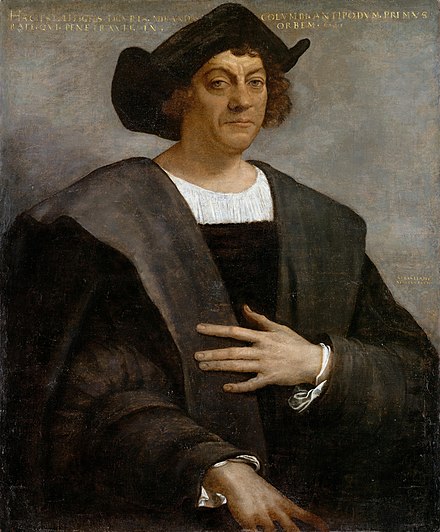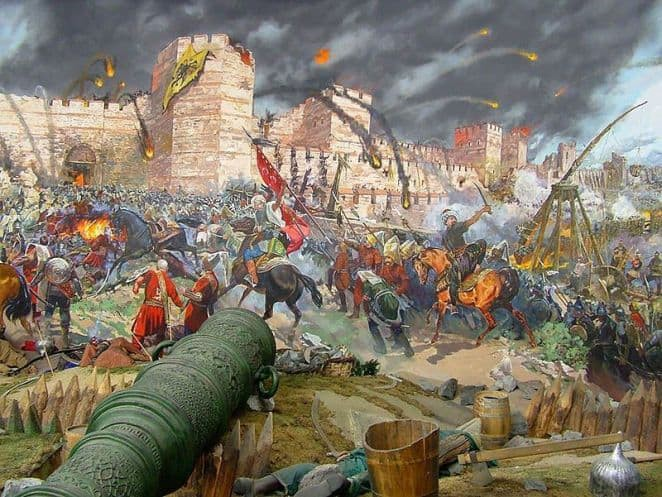At any rate, we will find out, as it is now time to return to the man about whom this whole article is being written.
Oh, you were wondering when we’d get back to him, were you? Well, had to set the scene, and now that we’ve done that, back we go.
And I mean back.
 Christopher Columbus (1451 - 1506)
Christopher Columbus (1451 - 1506)
Though little is really known of Columbus’s birth or even his early life, most seem to agree that he came from Genoa, one of the states of what would become Italy, and his father, Domenico, looks to have married into money, as he was a mere wool weaver who also ran a cheese shop on the side, whereas his wife, Susanna Fontanarossa (sounds like an Italian sports car!) was the daughter of a wealthy real estate developer in Corsica. Christopher was the first son of Domenico and Susanna, and three more would arrive along with the last, a daughter. One of his brothers, Bartolomeo, would go on to be a map-maker, and Christopher himself would study at the University of Pavia, though at age fourteen he would leave - whether this means he dropped out, graduated or was expelled we have no idea due to the scarcity, almost non-existence of records of his early life, but there is no mention made later of any disgrace, so it may reasonably be assumed, I would think, that he either completed his studies or that the call of the sea proved too strong for him to remain in education. What exactly contributed to his interest in the life of a mariner I have no clue; there was no history of either naval service or exploration or even trade on his father’s side, and his mother came from a line of realtors, so it’s doubtful there was any wanderlust in the Fontanarossas either.
It could of course have been the simple desire to see beyond his own country that drew Columbus to the sea. In a time where the only way to see other lands was to take passage on a ship, it’s possible he just decided he wanted to see more of the world. Perhaps his studies (geography and navigation were among the subjects he took at the university, perhaps underlining how common it might be for young men to become sailors) gave him the spur; perhaps learning about other countries, and also how to handle and navigate a ship, might have instilled in him a desire to put that knowledge into practice and make a name for himself. It’s probably likely - almost certain, one would assume, at that age - that he started as a cabin boy on some ship and, literally, learned the ropes, until he was able to captain his own ship. And then of course there were always wars, and wars need ships and ships need captains. Columbus was involved in the war between Genoa and Venice from 1461- 1463, and commanded a fleet of galleys near Cyprus.
"In 1477," he says, in one of his letters,
"in the month of February, I sailed more than a hundred leagues beyond Tile." By this he means Thule, or Iceland.
"Of this island the southern part is seventy-three degrees from the equator, not sixty-three degrees, as some geographers pretend."
But here he was wrong. The Southern part of Iceland is in the
latitude of sixty-three and a half degrees.
"The English, chiefly those of Bristol, carry their merchandise, to this island, which is as large as England. When I was there the sea was not frozen, but the tides there are so strong that they rise and fall twenty-six cubits."
It could also have had to do with the attack on Constantinople, which changed Europe fundamentally.
 The Fall of Constantinople (1453)
The Fall of Constantinople (1453)
Constantinople, now called Istanbul, was one of the great cities and centres of power of the medieval world. The hub of the mighty Byzantine Empire, and named after the first Roman emperor to legalise christianity, Constantine the Great, the city had stood for over a thousand years, and despite two attacks and sieges by Arabs, in 674 and 717, and Christian Crusaders in 1204, it was still standing by Columbus’s time. However, successive attacks by Latins, Bulgarians, Serbs and Ottoman Turks had reduced and weakened the city, and the arrival of the Black Death in 1346 did not help matters, wiping out nearly half of the city’s population, and leaving it ripe, once Europe had recovered from the Plague, for conquest. By 1450, the once-great city had shrunk to a few walled villages, the Byzantine Empire was on its last legs, and Constantinople was really nothing more than a shaky house of cards, just waiting for one push to bring it all down.
The ones to provide that push were the Turks of the Ottoman Empire.
Their new young ruler, Mehmed II, knew the history of his people and he wanted Constantinople back. He of course knew too how weak the ancient centre of the Byzantine Empire had become, and was eager to prove himself. He built a second fortress on the Bosphorus Strait, to complement the one built there decades ago by his great-grandfather, and effectively blocking off any potential aid which might come from Greece, where the brothers of Constantine XI, now ruling in what was left of Constantinople, held sway. Constantine turned to western Europe for help, but apart from there being bad feeling between him and the Pope, most of the European powers had just ended major wars, such as the Hundred Years War between France and England and the Reconquista, which had taken up most of Spain’s military and financial resources, so in effect Constantinople met the threat of the Turks without allies.
And they needed them. A force of about 7,000 defended the city, with the Turks mustering up to ten times that many, according to various estimates. Even the lower estimate though reckons their strength to have been 50,000, so at least seven to one. Plus they had cannon, about 70 of them, while the garrison had only a few old outdated and pretty low-powered pieces of artillery. The Ottomans had massive cannon which, though slow to reload - three hours - and unreliable were nevertheless devastating, and no doubt struck fear into the defenders when they saw them being hauled towards the city.
In the end, the Siege of Constantinople lasted 53 days, the city finally falling on May 29 1453, as the power of the Ottoman Empire was turned against Christendom. I suppose in twenty-first century terms the Fall of Constantinople might be equated, in terms of shock and disbelief, to the attack on the Twin Towers. It was a black day for Christianity, and though they hoped one day the city would be recovered it never was, as Istanbul, as it became known, is now the capital of Turkey, a Muslim nation.
What has all this to do with Christopher Columbus, I hear you ask? Well to be honest, I don’t know, but I imagine it must have had some effect upon his desire to explore and also to find new territories for the Spanish Crown in the face of the growing Muslim threat from the east. At any rate, we pick up the story of Columbus as he reaches his thirties, and marries Philippa de Perestrello, the daughter of another mariner, an ex-Portuguese governor, in 1477. It was from Lisbon that he began trying to solicit interest in his plan to reach Japan (known in Marco Polo’s famous travel book as Cipango) which he believed to be the closest point to Europe, and as he was in Portugal it only made sense to hit up the Portuguese King, John II, who had already authorised the voyage of Bartholomew Diaz to Africa, where the navigator had discovered the Cape of Good Hope.
At this time, it was still believed the only way to get to the East Indies was to sail east, down along the African coast, while Columbus’s idea was that if you sailed west, and the world was round, as most believed it was (though it had yet to be conclusively proven beyond doubt shut up Flat Earthers nobody cares) then the Indies could be reached that way, which would be a much shorter and quicker route. Mostly though, what he was offering was trade advantages. Spices, silks, carpets, drugs were all imported from India, and very popular. If they could be transported faster and more conveniently by his proposed route, the monarch who cornered that enterprise would stand to become rich as, well, a king, but a very rich king. Perhaps several. Not to mention the prestige that would accrue to him.
However now we come to the crux of the matter. Columbus explained his vision to King Alphonso V, but he rather inconveniently died in 1481 and passed the throne to his son, John II, who nodded and smiled as Columbus explained his plan, then went and gave it to another mariner to try out, before he shelled out the readies. Sadly for this sailor, and the king, but not for Columbus, the big girl’s blouse got scared of an iddy-biddy massive storm and fu
cked off back home. John hadn’t let on about his “test run”, but when the fleet came back into Lisbon harbour trailing a brown streak in the sea, he knew which was the wind blew (well he would, wouldn’t he, being a sailor and all?) and told John exactly where he could stuff it, and in high dudgeon (no point being in low dudgeon; might as well not be in any dudgeon at all if you’re not going to be in high) he sodded off to Spain, where history was about to be made, leaving John II of Portugal most likely slapping his forehead and muttering “F
uck.”
So, although he hadn’t actually asked the Duke of Milan for help, being an Italian that was technically Italy and now Portugal down.
Third time’s the charm.